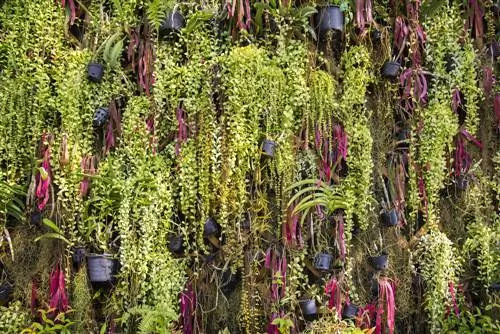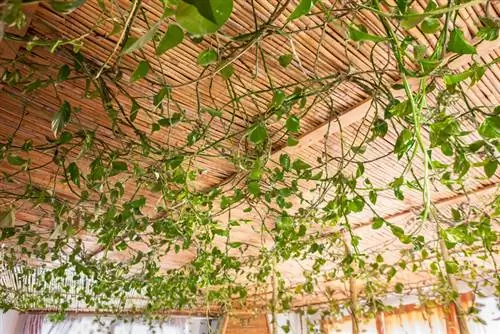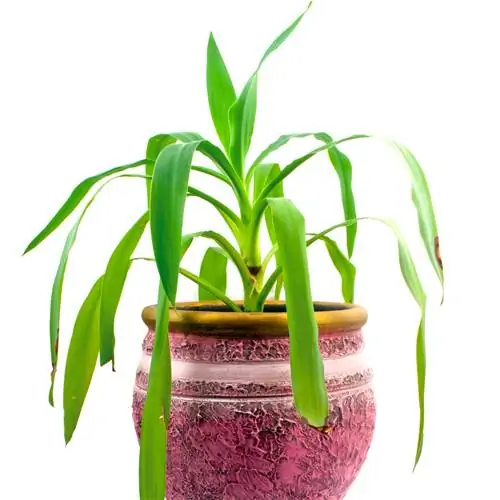- Author admin [email protected].
- Public 2023-12-26 14:17.
- Last modified 2025-01-23 11:22.
The idea of vertically arranged gardens originated thousands of years ago. While nature is considered a model, physical forces are tricked into modern objects. Imagination is the reason for numerous reinterpretations and so the hanging gardens have also conquered the living room.
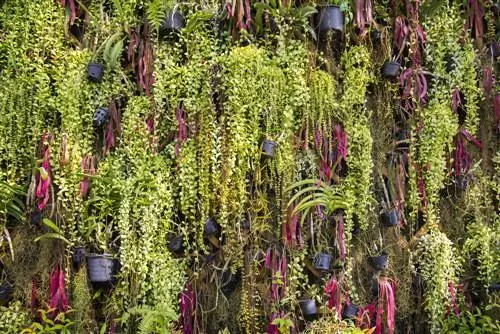
What are the Hanging Gardens of Babylon and their significance today?
The Hanging Gardens of Babylon are considered one of the seven ancient wonders of the world, whose existence is still controversial today. They were probably founded by the Babylonian king Nebuchadnezzar II in the 6th century BC. Built. Today, hanging gardens inspire modern architectural and horticultural projects worldwide, in both public and private spaces.
A look into history
One of the seven wonders of the ancient world was a garden as a unique legacy of humanity. At that time, the Hanging Gardens were located in Babylon, which is modern-day Iraq. It was one of the most important metropolises in ancient times. However, there is little reliable evidence as to when the wonder of Babylon existed. The Babylonian king Nebuchadnezzar II, who reigned from 605 to 562 B. C. The building army is said to have been the construction army.
Historical traditions:
- Antipater of Sidon named the gardens in a poem
- Diodoros Sikulos records in writing that there was no obvious mechanism for transporting water
- Strabo described geography
- Philo of Byzantium wrote a kind of travel guide to the seven wonders of the world
Impressive production
The dimensions of the entire complex have been handed down. It is said to have been around 120 meters wide and long and reached a height of 24 meters. The staircase to the garden is said to have been inclined like a slope and covered by huge terrace steps. Countless exotic plants grew on the roofs and water was considered the determining element.
In order to irrigate the plants, a complex system was necessary that obtained water from the tributaries of the Euphrates. The individual parts of the impressive building were arranged in steps and criss-crossed by corridors. The builder managed to create an appearance that was probably intended to be reminiscent of a theater. Such images of rushing water and magnificent greenery in the middle of a desert probably inspired the imagination.
Mistakes, myths and theses

There is less than a handful of data that could actually be proven. Researchers continually come across information that leads to new theories. But to this day it is still controversial as to which facts are true and which are the result of fantasy.
Name confusion and builder chaos
The hanging gardens were actually not real vertical plant arrangements but rather terraced bed arrangements. This myth is due to a translation error from Greek into German. The term 'roof garden on terraces' would be more correct. Historians agree that the hanging gardens were not commissioned by Semiramis. She was queen of Babylonia about 200 years before Nebuchadnezzar II. The king is said to have built the complex for his wife Amyitis.
Unworthy of a wonder of the world
At the beginning of the 20th century, the German archaeologist Robert Koldewey discovered two palaces, one of which may have been the Garden of Semiramis. His assumption was supported because the palace contained vaulted substructures, fountains and unusual pottery shards. However, the side length was only 45 meters. For many scientists, such a palace is not worthy of a wonder of the world.
Such gardens were also normal for the ancient Babylonians, as many kings built such facilities for recreation. The Greeks saw these buildings in a different light. Gardens must have been special to them because they didn't know about them. This could have given this small garden its legendary reputation.
Dubious existence
It is believed that as early as 100 BC. Large parts of the hanging gardens of Semiramis were destroyed. At this time the people of Babylon left their city. The existence of this powerful facility is often questioned. Herodotus, who is considered the father of historiography, also says nothing about the gardens in his surviving work. In this universal story, which tells from the rise of the Persian Empire to the Persian Wars, there is no detail about the wonder of the world.
Hanging gardens today
The history of these mighty gardens continues to provide new inspiration. City planners, landscape architects and the tourism industry use the idea of hanging gardens for their projects. Plants in a vertical arrangement create a new atmosphere and literally expand your horizons. But even in nature, corresponding structures develop if the conditions allow it.
| Where? | What is this? | Special feature | |
|---|---|---|---|
| Hanging Gardens of Ehrenfeld | Cologne | Bar | countless plastic roses on the ceiling |
| Vertical Living | Singapore | Design project for a better quality of life | green facades, terraced plantations and roof terraces |
| Hanging Gardens Ubud | Bali | Luxury resort | Plant on a 45 degree slope |
Jardins suspendus of Le Havre
The hanging gardens were created in an old 19th century fortress and blend in with the remains of the former bulwarks, battlements, ditches and powder rooms. Visitors experience a botanical trip around the world. Types of vegetation from southern regions, North America and East Asia are shown in various themed gardens. In the middle of the courtyard there are greenhouses with fragrant plants from the tropics.
Hanging Gardens of Mumbai
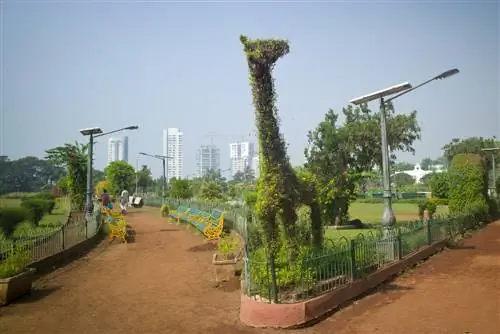
The Hanging Gardens in Mumbai are not hanging, but are constantly being expanded
In the middle of Mumbai's residential area, where the upper class lives, lies Malabar Hill. A work of art of horticulture has developed here, which is continually expanded and redesigned. Countless gardeners prune shrubs and bushes and give them the shape of elephants, monkeys and giraffes. It's worth taking a walk at night. Then the heat of the day has subsided and the largely shadeless facility offers an impressive view over the city lights.
Historic hanging garden of Neufra
This Renaissance garden was commissioned between 1569 and 1573. Count Georg von Helfenstein had the natural castle hill expanded with a flat area supported by vaults up to nine meters high. A garden was built on this level. It is a combination of horticulture and architecture for which the count found inspiration in other countries.
Hanging gardens have always inspired human imagination. They are an oasis of relaxation and a center of inspiration at the same time.
Hanging Gardens of Zion
Zion National Park is located in southwest Utah in the USA. The plateaus, which are divided by numerous gorges, are characteristic. The slopes of these canyons are extremely diverse and divided into small areas. Depending on the nature of the subsoil and the direction of the sun, completely different ecosystems have developed in the immediate vicinity. Hanging gardens have been created in the places where the water emerges from the rock.
Diverse flora on the walls:
- Ferns and wood sorrel hang meters down into the depths
- Beards made of moss grow over eroded rock edges
- Yuccas assert themselves on the bare rock of the southern slopes
- crippled junipers despite the scorching sun
- small pines and oaks cling to rock crevices
Bahai World Center in Israel

The Baha'i World Center in Israel is a symbol of peace
The Bahai Hanging Gardens are located in Haifa on Mount Carmel. They are among the most popular tourist attractions and are not only considered places of rest and relaxation. The gardens on the mountainside are a symbol of peace. It was designed by the Iranian architect Fariborz Sahba and shows various elements of Persian gardens. The hanging gardens form an axis connecting the two main Baha'i religious centers. In 2008 the garden was declared a UNESCO World Heritage Site.
Design ideas for the apartment
Plants in a vertical orientation continue to fascinate people to this day. They create a mystical atmosphere and are particularly attractive because of their overhanging shoots and leaves. Due to the large space savings, hanging gardens are becoming increasingly important.
Botanic Horizon
In the Ore Mountains, a managing director of a textile company has reinterpreted the theme of hanging gardens. BOHO or BOTANIC HORIZON is a semi-transparent and vertically constructed string system on which useful and ornamental plants grow. This design enables space-saving installation even in small rooms. The model can be hung up so that it functions as a decorative element on the wall or room divider. The inventor's inventiveness does not stand still and so he went into the lion's den with his startup to attract investors.

How the hanging garden works:
- Fill seeds at the junction points
- irrigate from above with nutrient solution
- Plants develop roots around the cords
Vertical Green Design
If you visit Thomas Gessler in his small Kreuzberg shop in Berlin, you will immerse yourself in a vertical jungle of ornamental and useful plants. Here ferns, tillandsias and ivy grow vertically without any soil and surrounded by a frame. From 60 euros you can get a piece of jungle for your own four walls. But the business owner also creates vertical vegetable and herb gardens with tomatoes and arugula. The plants grow in a substrate made of open-pored foam that provides secure support for the roots. Irrigation takes place via a water tank or with a sprayer.
Excursus
Future ideas
Vertical gardens are also gaining importance in global agriculture. Vertical farming is an idea that aims to ensure a sustainable supply of food for people in metropolitan areas. The basis is multi-story buildings, the so-called farm scrapers. Edible mushrooms, vegetables and fruits as well as algae are to be produced all year round on several levels arranged one above the other. This is intended to save energy costs for transport and minimize carbon dioxide emissions.
Design your own hanging gardens
Queen Semiramis, who is associated with the hanging gardens, is long gone. But the idea of vertically oriented plant arrangements has persisted to this day. The difficulty is finding suitable plants. Not all plants feel comfortable on the wall in low-light conditions. Special plant lamps can help.
Gardens made from PET bottles

A hanging garden can be quite inexpensive
You don't necessarily have to buy materials for the design. Many things can be transformed into a hanging garden using simple means. Use several PET bottles and decorate them with paint, letters or adhesive foil. Place the bottles on a table and draw a rectangle on the top of the bottle. This opening is cut out with a craft knife.
Drill two holes in the plastic at the back. A nylon cord is threaded here on which the vessels are hung. To prevent them from slipping out of the openings, you should attach each end to a small piece of toothpick. Fill the bottles with a substrate that is tailored to the plants and plant the desired plants.
These plants are suitable:
- Kitchen: basil, chives, marjoram
- Living room: Cacti and succulents
- Bathroom: tillandsias, bromeliads, orchids
Tip
Apply paint with a paint roller. This creates a beautiful effect.

Green wall for the balcony
Green wall frames are ideal as privacy screens in the garden or on the balcony. But they can also be mounted directly on the facade to beautify it. Lay hoses in the filler that use a pump to transport water from a reservoir and supply the plants. The water drips into the filler through small holes in the hose.
Instructions for building:
- Attach steel mesh to a bare outside wall
- Attach a plastic net with a mesh size of five millimeters in front of the steel mesh
- Glue on the rock wool mat
- Complete the structure with stainless and small-mesh wire
In this sandwich structure, the plants find enough support to root and the facade is protected by the plastic film. This also serves as insulation against cold from the wall. Evergreen foliage perennials that survive longer dry periods are ideal for planting.
Tip
This variant can also be designed as a mini version for the living room. You can frame the wall and plant it with tillandsias.
Frequently asked questions
How did the Hanging Gardens come about?
Theories say that Babylonian King Nebuchadnezzar II had the gardens built for his wife. This came from a very green landscape in Persia and was intended to be reminiscent of its homeland through the gardens. The defining elements were not only countless tropical plants but also water.
When were the Hanging Gardens of Babylon destroyed?
There is no evidence of the demise of the mighty garden complex. The building probably no longer existed when people lived around 100 BC. Left Babylon in 300 BC. Scientists doubt its existence because even the infamous storyteller Herodotus didn't say a word about the facilities.
Did the Hanging Gardens actually exist in Babylon?
Some scholars argue that the gardens were not built in Babylon but in Nineveh and were part of Sennacherib's palace there. They refer to historical sources, topological finds and interpretations of works of art.
Are there hanging gardens for the living room?
There are more and more models on the market that are arranged vertically. NatureUp is a plug-in system (€81.00 at Amazon) from Gardena that can be individually designed and expanded with irrigation systems and corner elements. You can make hanging plant arrangements yourself using discarded objects. Gutters, picture frames or plastic bottles are suitable for this.

